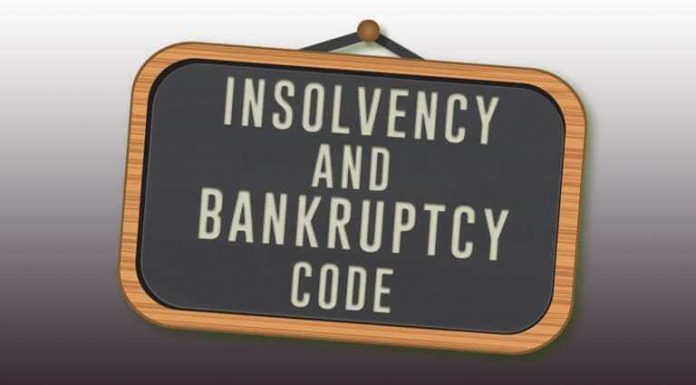This article is written by Sumer Karekar, pursuing a Certificate Course in Insolvency and Bankruptcy Code from Lawsikho.com.
Table of Contents
Introduction
Prior to the emergence of the Insolvency Code (“Code”), the Indian bankruptcy resolution regime was governed by the Sick Industrial Companies Act, 1987, which aimed to promote the revival of companies under financial stress. The statute facilitated the setting up of the Board for Industrial and Financial Reconstruction (BIFR) which was responsible for the detection of financially unhealthy enterprises and facilitated the process of their revival. Despite the noble conceptualization, the Act failed to achieve its objectives; predominantly due to a number of inconsistencies in the Act. Subsequently, the Insolvency and Bankruptcy Code was implemented in order to entirely overthrow the previous regime and establish a more reliable and efficient framework of laws for the resolution of debt-ridden companies.
Purpose and objectives of the Code
In so far as the purpose of the Code is concerned, its primary goal was to maximize the value of the corporate debtors’ assets and to ensure proportional and equitable repayment of amounts due to the various stakeholders involved. The grand scheme of the Code was laid upon the foundation of maintaining a company as a “going concern”. Where its business operations otherwise add value to society, the company should not be discouraged due to financial disability and must be revived and allowed to continue, albeit under a new management.
Although the Code also provides a distinct set of provisions for liquidation of the corporate debtor, it is pertinent to note that this shall only occur where all other efforts towards resolution of its debts have failed and liquidating its assets is the only beneficial option. Therefore, resolution of a company is of topmost priority under the Code in order to promote business and entrepreneurship in the country.
Notably, the Code stipulates that the corporate insolvency resolution process must be completed within a total period of 180 days, from the date of admission of the application. Although, the timeline has now been extended to beyond 330 days under exceptional circumstances, as determined by Nariman. J. in the case of Committee of Creditors for Essar Steel v. Satish Kumar Gupta, we observe that the primary objectives of the Code are to guarantee speedy resolution of debts and to maximize the value of the assets of the corporate debtor.
Jurisprudence behind the enactment of the Insolvency and Bankruptcy Code
As part of its grand scheme, the Insolvency Code has been built on the foundation of encouraging entrepreneurship in India. As described by Leon Forman (1978) in his article on the American bankruptcy regime, ”the filing of a bankruptcy case acts as a shelter over the assets of the debtor, and all action by creditors against the debtor and the assets are automatically stayed, with some limited exception”, thus allowing the creditors, the trustees and courts “to conduct financial affairs of the company”. Similarly the IBC envisaged a protective mechanism for the assets of the corporate debtor, thereby allowing proportional payment of the amounts due to creditors.

Banking Law Reforms committee report
In the proposition put forward by the Bankruptcy Law Reforms Committee (BLRC) in 2015 for the establishment of the IBC, the Committee set forth the following seven principles upon which the Code shall primarily function;
“…
- To facilitate the assessment of viability of the enterprise at a very early stage.
- To enable symmetry of information between creditors and debtors.
- To ensure a time-bound process to better preserve economic value.
- To ensure a collective process.
- To respect the rights of all creditors equally.
- To ensure that, when the negotiations fail to establish viability, the outcome of bankruptcy shall remain binding.
- To ensure clarity of priority, and that the rights of all stakeholders are upheld in resolving bankruptcy.“
From prima facie perusal of the aforementioned principles, it is evident that Code has been established particularly considering the policy of public welfare. Moreover, in the case of Swiss Ribbons v. Union of India, the Supreme Court discussed the constitutionality of the legislation and concluded as follows;
“… the primary focus of the legislation is to ensure revival and continuation of the corporate debtor by protecting the corporate debtor from its own management and from a corporate death by liquidation. The Code is thus a beneficial legislation which outs the corporate debtor back on its feet, and not being a mere recovery legislation for creditors.”
Besides being non-adversarial in nature, the Code has stipulated timelines from each part of the process involved, in order to ensure greater expediency and certainty in the completion of the process, in contrast to the older regime wherein the time value of money was lost.
The BLRC, in their report, further observed the unhealthy credit-environment prevalent in India. As per their findings, the estimated recovery rates of financial debt remained low despite the rights bestowed upon the creditors by the SARFAESI Act. The report further stated:
“Better access to credit for new entrepreneurs will create greater dynamism by increasing competition.”
Several other important factors upon which the enforcement of the Code was based were the slow and ineffective process of the debt resolution, the failure of auctions, the super-normal prioritization given to secured creditors and the lack of sound infrastructure for the revival of financially unhealthy enterprises.
Insolvency Law committee report
In so far as the classification of creditors and their treatment is concerned, the Report of the Insolvency Law Committee must be considered. In response to a query with regard to bestowing voting rights upon creditors based on how the process impacted their debts, the Committee opined as follows:
“… the distinction between creditors under the Code is based on the kind of debt owed to them, and not their treatment under the resolution plan.
… the distinction between ‘financial’ and operational’ creditors has been made keeping in mind the Indian ecosystem and the sophistication of creditors.”
Thus, we observe that the Code has been drafted to mindfully exclude a ‘class-based’ mechanism for the treatment of creditors, whereby only creditors whose debts have been altered by the plan are considered, given that it has proven rather ineffective in the preceding Indian debt-restructuring and liquidation regime.
Jurisprudence behind the development of the current scenario of the Insolvency and Bankruptcy Code, 2016
So far, the Insolvency & Bankruptcy Code has been touted as a dynamic and highly adaptable legislation. The Adjudicatory Authorities under the Code have been granted wide powers to encourage the development of jurisprudence and the resolution of grey areas, specifically considering that the statute is fairly nascent and may have several inconsistencies. This has promoted immense deliberation and amendment of the provisions of the Code.
Constitutional validity of the Code
Immediately after the emergence of the IBC in 2016, the landmark case of Sree Metaliks Ltd. v. Union of India (2017) raised doubts regarding the constitutional validity of Section 7 of the Code; on the grounds that the phraseology of the provision did not expressly provide the corporate debtor the right to be heard. Upholding the constitutionality of the Code, the Court established that where a legislation does not expressly deny the right to be heard, the same shall be read into the provision in adherence to the principles of natural justice.
Eventually, in Akshay Jhunjhunwala and Anr. v. Union of India (2018), the Court further strengthened the stance regarding the constitutionality of the Code and cleared the air around the composition of the Committee of Creditors under the Code. Basak J., resorting to the BLRC Report, opined that the differentiation between financial and operational creditors stipulated by the Code, with respect to the formation of the Committee of Creditors, has been deliberately established to ensure the expedient resolution of the insolvency of the corporate debtor and thus, does not render the Code unconstitutional.
Expedient resolution of Insolvency and the classification of creditors
Subsequently, in Committee of Creditors for Essar Steel v. Satish Kumar Gupta (2019), questions regarding the time-period for the insolvency resolution process and the construction of Section 12 of the Code were scrutinized by the apex court. Here, Nariman J., while eliminating the compulsory 330-day deadline for the completion of the insolvency resolution process, stated the following:
“… while leaving the provision otherwise intact, we strike down the word “mandatorily” as being manifestly arbitrary under Article 14 of the Constitution of India and as being an excessive and unreasonable restriction on the litigant’s right to carry on business under Article 19(1)(g) of the Constitution.”
The use of a constitutional doctrine by the apex court brought about a crucial change to the method of construction of Section 12 i.e. the timeline for the completion of the resolution process. In the aftermath of this decision, the 330-day timeline was inclusive of any additional time required for litigation, thereby further widening the powers of the Adjudicatory Authority in exceptional cases.
Further, the Essar Steel case also recalibrated the consideration given to operational creditors under the Code. Although the financial creditors are entitled to constitute the Committee of Creditors, they are bound by the duty of establishing a resolution plan, keeping in mind the best interests of the operational creditors. According to the rationale on the Supreme Court, although advancement of funds is key for the growth of business, however, an enterprise cannot operate without suppliers of goods/services and its employees i.e. operational creditors.
“Financial debt” and homebuyers under the Code
As jurisprudence evolved over time, certain issues requiring special consideration of the ground reality and the socio-economic status quo began to arise. With respect to the question of homebuyers and their claims under the Code, the Court, in Pioneer Urban Land and Infrastructure Limited & Another v. Union of India & Others propounded that for the purpose of the Code, homebuyers are financial creditors, as the funds they advance to the developer is for the construction of a future asset, thereby having the effect of a commercial borrowing. Consequently, an Ordinance was passed which amended Section 5(8) of the Code, thus modifying the definition of “financial debt”.
Conclusion
It is clear that the Insolvency and Bankruptcy Code is a highly flexible piece of legislation, open to reasonable modification in adherence to public policy and socio-economic development. Ever since the inception of the Code in 2016, the Adjudicatory Authority and the Supreme Court have fervently endeavoured to resolve the grey areas of the law, thereby clarifying the methods of interpretation adopted, as well as the phraseology of its provisions for future application. Although the cases discussed above capture only a fraction of the developments that have occurred so far, the rationale adopted by the judiciary promises a bright future for the Indian insolvency resolution regime.
Students of Lawsikho courses regularly produce writing assignments and work on practical exercises as a part of their coursework and develop themselves in real-life practical skill.
LawSikho has created a telegram group for exchanging legal knowledge, referrals and various opportunities. You can click on this link and join:











